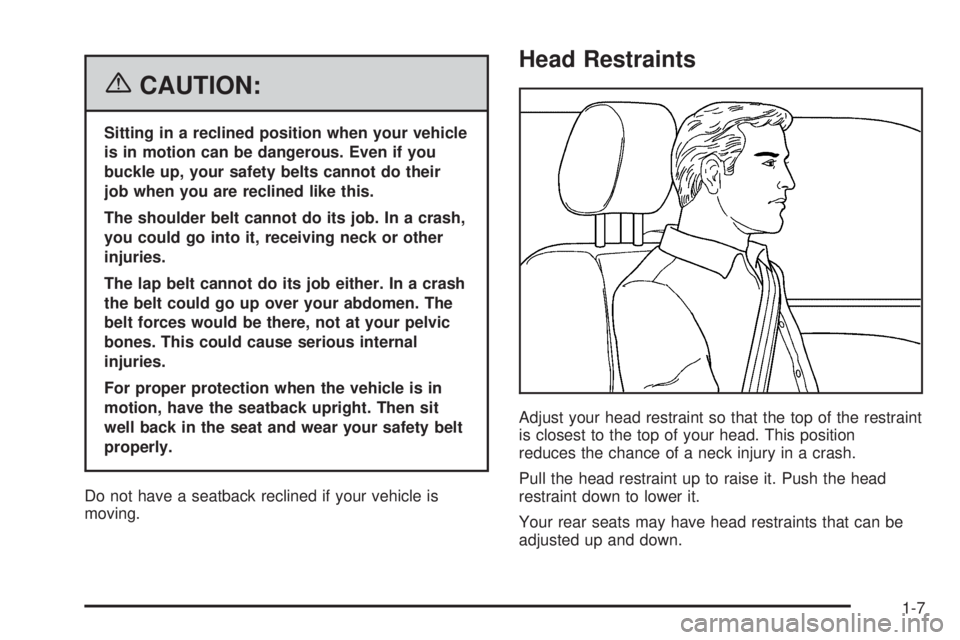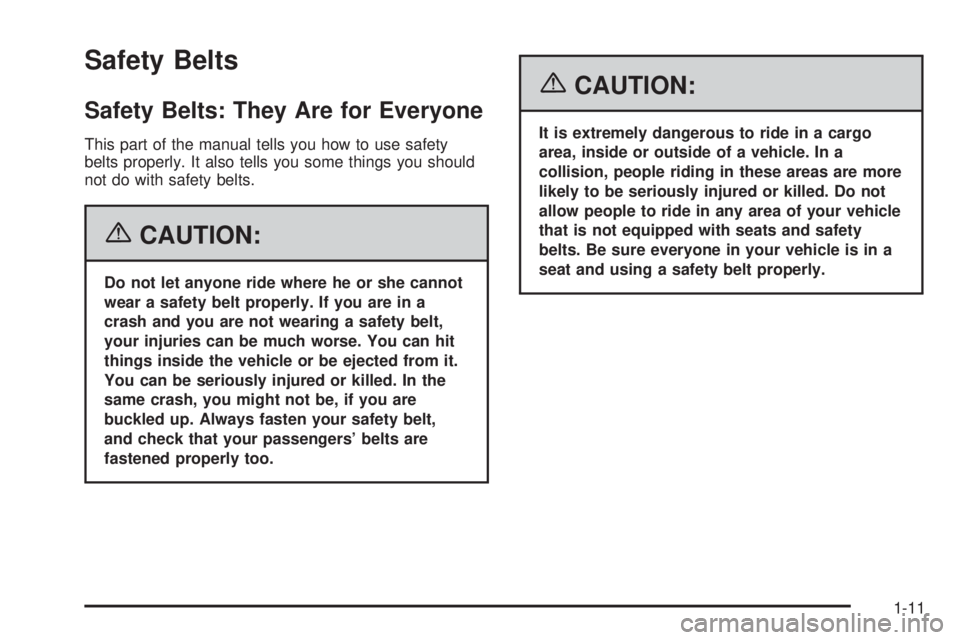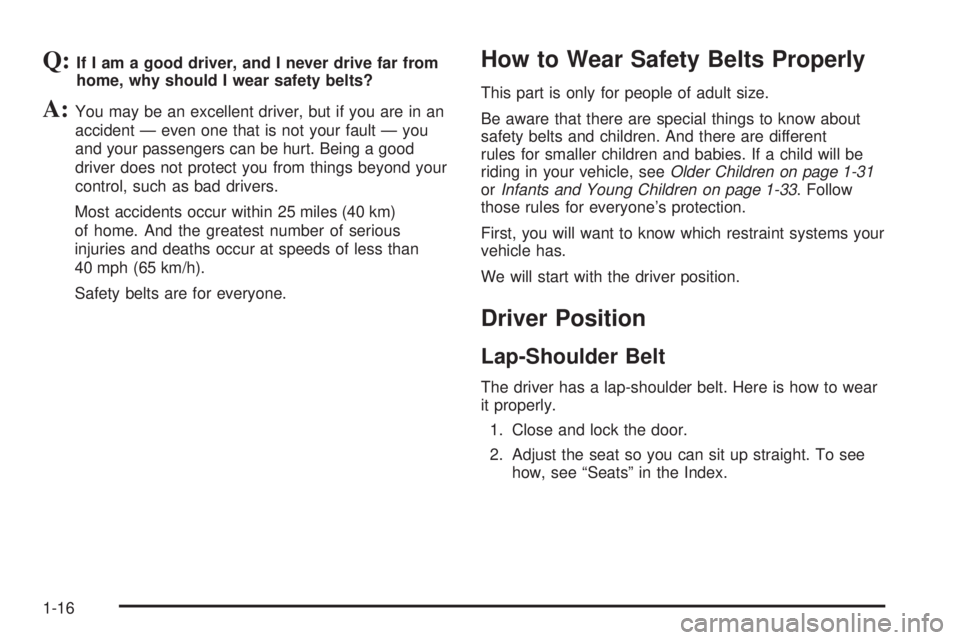Page 13 of 600

{CAUTION:
Sitting in a reclined position when your vehicle
is in motion can be dangerous. Even if you
buckle up, your safety belts cannot do their
job when you are reclined like this.
The shoulder belt cannot do its job. In a crash,
you could go into it, receiving neck or other
injuries.
The lap belt cannot do its job either. In a crash
the belt could go up over your abdomen. The
belt forces would be there, not at your pelvic
bones. This could cause serious internal
injuries.
For proper protection when the vehicle is in
motion, have the seatback upright. Then sit
well back in the seat and wear your safety belt
properly.
Do not have a seatback reclined if your vehicle is
moving.
Head Restraints
Adjust your head restraint so that the top of the restraint
is closest to the top of your head. This position
reduces the chance of a neck injury in a crash.
Pull the head restraint up to raise it. Push the head
restraint down to lower it.
Your rear seats may have head restraints that can be
adjusted up and down.
1-7
Page 14 of 600

Seatback Latches
The front seatbacks fold forward to allow access to the
rear of the cab.
To fold the seatback forward, lift the lever located on
the outboard side of the seat cushion.
{CAUTION:
If the seatback is not locked, it could move
forward in a sudden stop or crash. That could
cause injury to the person sitting there. Always
push and pull on the seatback to be sure it is
locked.
To return the seatback to the upright position, push the
seatback rearward until it latches. After returning the
seatback to its upright position, push and pull on
the seatback to make sure it is locked.
Rear Seats
Rear Seat Operation (Extended Cab)
Folding the Rear Seat
The rear seat in the extended cab can be folded up to
provide more cargo space.
To fold the seat up, do the following:
1. Push down on the front
of the seat cushion
while pulling down on
the release strap
which is located under
the seat cushion.
2. Pull the seat cushion up until it latches with the
seatback.
3. After latching the seat cushion up, pull forward on it
to make sure it is locked.
1-8
Page 17 of 600

Safety Belts
Safety Belts: They Are for Everyone
This part of the manual tells you how to use safety
belts properly. It also tells you some things you should
not do with safety belts.
{CAUTION:
Do not let anyone ride where he or she cannot
wear a safety belt properly. If you are in a
crash and you are not wearing a safety belt,
your injuries can be much worse. You can hit
things inside the vehicle or be ejected from it.
You can be seriously injured or killed. In the
same crash, you might not be, if you are
buckled up. Always fasten your safety belt,
and check that your passengers’ belts are
fastened properly too.
{CAUTION:
It is extremely dangerous to ride in a cargo
area, inside or outside of a vehicle. In a
collision, people riding in these areas are more
likely to be seriously injured or killed. Do not
allow people to ride in any area of your vehicle
that is not equipped with seats and safety
belts. Be sure everyone in your vehicle is in a
seat and using a safety belt properly.
1-11
Page 22 of 600

Q:If I am a good driver, and I never drive far from
home, why should I wear safety belts?
A:You may be an excellent driver, but if you are in an
accident — even one that is not your fault — you
and your passengers can be hurt. Being a good
driver does not protect you from things beyond your
control, such as bad drivers.
Most accidents occur within 25 miles (40 km)
of home. And the greatest number of serious
injuries and deaths occur at speeds of less than
40 mph (65 km/h).
Safety belts are for everyone.
How to Wear Safety Belts Properly
This part is only for people of adult size.
Be aware that there are special things to know about
safety belts and children. And there are different
rules for smaller children and babies. If a child will be
riding in your vehicle, seeOlder Children on page 1-31
orInfants and Young Children on page 1-33. Follow
those rules for everyone’s protection.
First, you will want to know which restraint systems your
vehicle has.
We will start with the driver position.
Driver Position
Lap-Shoulder Belt
The driver has a lap-shoulder belt. Here is how to wear
it properly.
1. Close and lock the door.
2. Adjust the seat so you can sit up straight. To see
how, see “Seats” in the Index.
1-16
Page 35 of 600
Rear Safety Belt Comfort Guides
Rear seat comfort guides may provide added safety belt
comfort for older children who have outgrown booster
seats and for some adults. When installed on a shoulder
belt, the comfort guide positions the belt away from the
neck and head.
There is one guide for each outside passenger in the
rear seat. Here is how to install a comfort guide and use
the safety belt:
1. Remove the guide from its storage clip on the
interior body.
2. Place the guide over the belt and insert the
two edges of the belt into the slots of the guide.3. Be sure that the belt is not twisted and it lies �at.
The guide must be on top of the belt.
1-29
Page 36 of 600

{CAUTION:
A safety belt that is not properly worn may not
provide the protection needed in a crash. The
person wearing the belt could be seriously
injured. The shoulder belt should go over the
shoulder and across the chest. These parts of
the body are best able to take belt restraining
forces.4. Buckle, position, and release the safety belt as
described inRear Seat Passengers on page 1-26.
Make sure that the shoulder belt crosses the
shoulder.
To remove and store the comfort guides, squeeze the
belt edges together so that you can take them out of the
guides. Slide the guide onto the storage clip.
Safety Belt Extender
If the vehicle’s safety belt will fasten around you, you
should use it.
But if a safety belt is not long enough, your dealer will
order you an extender. It is free. When you go in to
order it, take the heaviest coat you will wear, so
the extender will be long enough for you. To help avoid
personal injury, do not let someone else use it, and
use it only for the seat it is made to �t. The extender has
been designed for adults. Never use it for securing
child seats. To wear it, just attach it to the regular safety
belt. For more information, see the instruction sheet
that comes with the extender.
1-30
Page 37 of 600
Child Restraints
Older Children
Older children who have outgrown booster seats should
wear the vehicle’s safety belts.
Q:What is the proper way to wear safety belts?
A:An older child should wear a lap-shoulder belt and
get the additional restraint a shoulder belt can
provide. The shoulder belt should not cross the face
or neck. The lap belt should �t snugly below the
hips, just touching the top of the thighs. It should
never be worn over the abdomen, which could
cause severe or even fatal internal injuries in
a crash.
Accident statistics show that children are safer if they
are restrained in the rear seat.
In a crash, children who are not buckled up can strike
other people who are buckled up, or can be thrown
out of the vehicle. Older children need to use safety
belts properly.
1-31
Page 44 of 600
A forward-facing child seat (C-E) provides restraint for
the child’s body with the harness and also sometimes
with surfaces such as T-shaped or shelf-like shields.A booster seat (F-G) is a child restraint designed to
improve the �t of the vehicle’s safety belt system. Some
booster seats have a shoulder belt positioner, and
some high-back booster seats have a �ve-point harness.
A booster seat can also help a child to see out the
window.
1-38